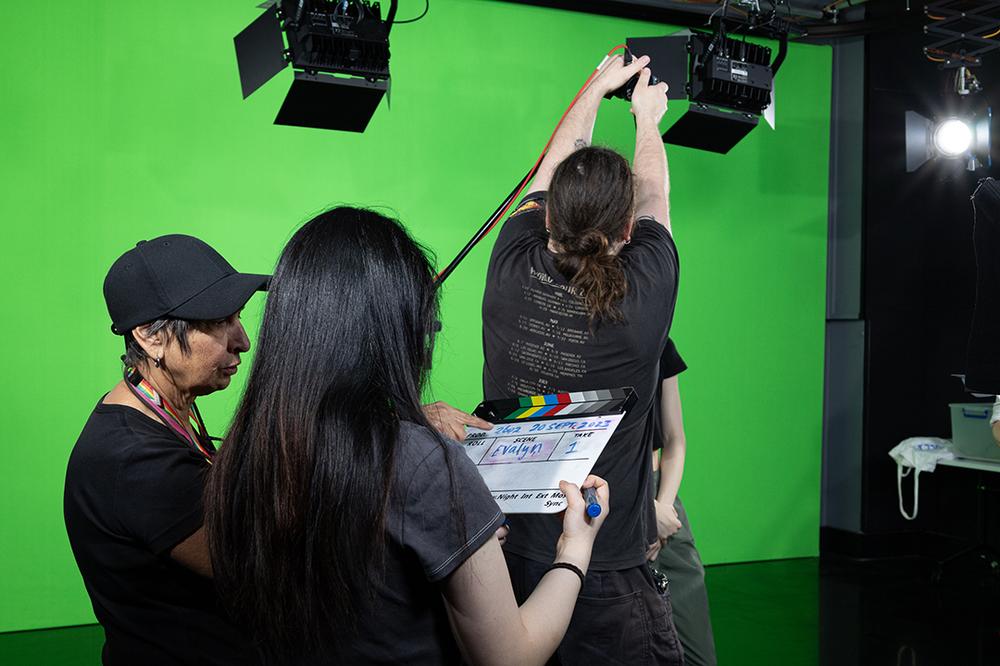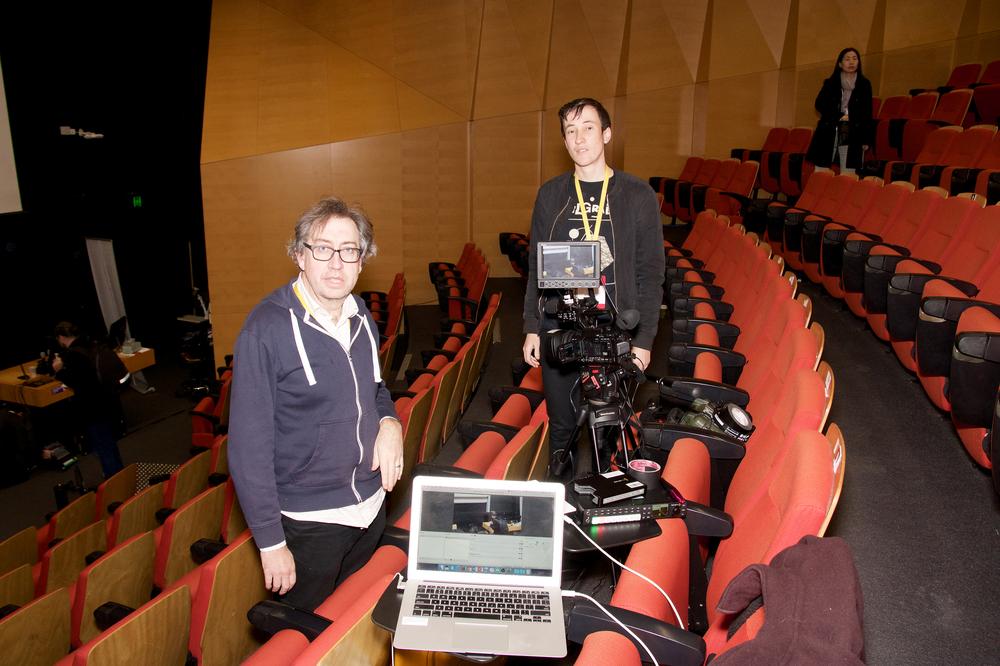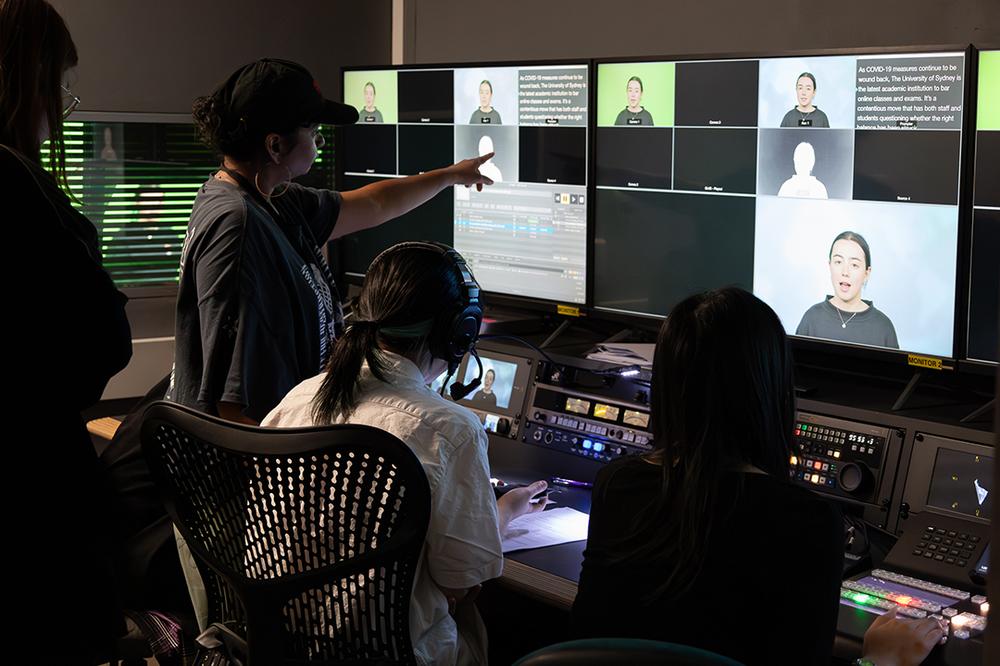6
“The glue that holds MECO together”: Digital Media Unit
“The glue that holds MECO together”
The Digital Media Unit (DMU) was formed in 2011 to service the growing practical and technical needs of MECO and the School of Literature, Art and Media (SLAM). Previously, these needs had been met by Arts Digital, which operated at a faculty level, but the model needed to adapt to an increasing demand for more hands-on learning. In Arts Digital, MECO was supported by Adrian Langker, Daragh Lane and Justin Flynn, and later David Fay. Stephen Lambrinos managed this section.
A small advisory group, led by Steven Maras, came up with the design and staffing model of the DMU. Philip Glen was part of this group, brought on board because of his experience servicing the technical needs of the Journalism department at Charles Sturt University. Glen recalled that the DMU started out as a modest affair with facilities spread across the University, including a “tiny loans room”, now referred to as “the old, old loans store”, in the Brennan MacCallum Building. It operated with just four staff: Jacob Craig working in audio, Michael McCarthy (and shortly after Maria Barbagallo) working in video, Marc Fernando working in IT and Glen managing the unit. Richard Manner, a technical officer for Theatre and Performance Studies, also worked closely with the DMU from its inception.
When the DMU started, it was supporting four undergraduate subjects and two postgraduate courses annually. A decade later (at the time of writing in 2021), the DMU is supporting around 13 units a year and operating a slew of new facilities. Glen’s team also has doubled in size, with Barbagallo and Fernando joined by Shelagh Stanton, Josh Dowton, Mario Brce and Alexandra Spence. The once modest affair is now thriving and instrumental to the MECO program. As Blue Lucine, a documentary filmmaker who has been teaching at MECO since 2019 and who coordinates multiple media production units, put it, the DMU is “the glue that holds MECO together”.
From the outset, the DMU mandate has been to offer a technical production stream to run alongside the theoretical underpinning of the MECO program. As Glen explained, the fundamental aim has been for practitioners to supply direct support to units of study, to form relationships with students and allow students to learn by doing. Furthermore, the DMU has “provide[d] an environment where doing is possible without requiring a skills uptake of the current faculty and staff”.
Over the last decade, interest in the technical elements of MECO programs has grown immensely, and new units, such as podcasting, have seen huge enrolments. This growth has been fuelled by the increasing role of technology within society, including the affordability of professional-level consumer technology and the rising trend of YouTubers and podcasters. The increased demand for these units has meant an increased demand for practical assistance from the DMU.
Another impetus for growth and change within the DMU came from the Sydney College of the Arts (SCA) merging with the Faculty of Arts and Social Sciences (FASS) at the end of 2019. This saw the DMU loans store amalgamate with the SCA loans store, gaining both the technical equipment and the expertise of Brce, the SCA loans store officer.
Brce explained that “the DMU maintains the culture of two schools across a unified team”. Despite the initial growing pains – such as restructuring real estate to accommodate the additional loans gear, and learning and developing a new software program to monitor loans, facilities, and gear from both schools – the merge has been advantageous. Purchasing resources has become more streamlined, and resources can be pooled, such as the recent batch of GH5 cameras selected to service both media and SCA students.
The diversification and further specialisation have strengthened the DMU. “Having those smarts and those brains all in the one room, virtually or what have you, in the end game has to be positive,” said Brce. “I think it’s very useful to just be able to turn around to Rich or Maria, or anyone else in the room, and immediately grab onto specialist knowledge.”
Brce is referring to Richard Manner, who manages and services SLAM’s Rex Cramphorn Studio. Although Manner’s main priority is within Theatre and Performance Studies, he regularly interfaces with the DMU and generously offers his expertise and workshop facilities to assist with the repair of broken DMU equipment.
The DMU also has a strong alliance with the FASS Media Room, which was developed in 2017 in response to the growing need for a facility to assist with the creation of online educational material. The Media Room was designed by Glen, alongside the Social Sciences Building architects and ICT AV team. Jacob Craig – one of the DMU’s first employees – designed the room’s refurbishment and now services it, along with Tyler Mahoney.
The loans store operates in the John Woolley Building. The DMU technicians maintain close relationships with MECO and SCA academics to ensure they are sourcing the technical devices and equipment needed for each unit. But utilising high-level technology is not a requirement for making meaningful content, and in contemporary media and communications industries even mobile phones can be used to create impactful content. “Students at Sydney University learn to make meaningful communication rather than only learning about technology and how to use the big gear,” Glen said. Accordingly, the DMU provides everything from affordable consumer devices to high-end cameras.
The loans store also functions as a place where students and staff can go to gain tech support, advice and consultation. Glen explained, “The strength of the DMU is that an academic can walk down the hall and go, ‘I have an idea to do this thing, can we?’ and we go, ‘Well, let’s have a think about it’, propose a solution and go from there.”
Stanton also appreciates the student interactions that occur at the store. “Every year there’s one or two [students] that turn up a lot, borrow heaps of stuff, have a chat, ask for little favours and build a bit more of a relationship, which is really nice.”
Lucine has experienced this first-hand. “I know I can always count on them to bounce ideas off and that they’ll work with me to find the best solution to problems. They make time to explain things to students, and I know that I can trust them with providing hands-on support. I always say, ‘Go see the DMU, they’ll help you!’”
In addition to the loans store, the DMU also consists of audio podcasting, TV broadcasting and VR spaces located in the Education Building. Again, the DMU’s own officers – Glen and Stanton – played a large role in the design and build of these spaces, and they are serviced predominantly by Stanton and Barbagallo. This has resulted in what Brce described as a “continuous line of thought” from conception to development to practice. Stanton and Barbagallo also spend time in these learning spaces with students. As Barbagallo said, “In the early days we didn’t have the time, so we weren’t called upon to provide technical support in class – akin to a tutor. It’s developed more that way, and I think it’s a wonderful opportunity to pass on the knowledge you gain being a technical officer.”
The main podcasting studio was built in 2018, replacing a space in the Holme Building that had been used for audio work. The studio is booked for all the podcasting classes at both undergraduate and postgraduate level, and students can also access the studio independently. Initially built by Stanton to cater for MECO’s news bulletin and radio broadcasting courses, it has since been adapted to service the recent coursework move towards podcasting and post-production. As such, it consists of a broadcasting desk connected to the classroom next door and has podcasting microphones that allow for up to three guests to be interviewed at once.
The main facility for visual media is the TV broadcast studio and its associated vision switching room, audio mixing room and server room. Part of Barbagallo’s role is to prepare the TV studio for timetabled classes, to offer production support, and to ensure proper work health and safety standards are adhered to. Barbagallo explained that the TV studio offers students experience reading news, operating cameras, doing autocues and switching. She commented on the boom that TV broadcast has seen during COVID-19 and said she thinks “if anything it’s going to become more prominent”.
One of the newest facilities for the DMU is the Mixed Realities Lab, which is commonly referred to as the VR lab. The new lab, proposed by Fiona Martin and Gerard Goggin, was built in 2019 with the assistance of VR researcher Marcus Carter. It consists of a studio space with 20 high-end PCs and Oculus VR headsets, and a podcasting voiceover booth with an iMac computer, Rodecaster and microphones. It also has a VR cave – a 3 metre by 3 metre regulation space designed with a computer cupboard flush to the wall – enabling the whole space to be used for “room scale” VR. As Carter explained, “Rather than focusing just on facilities that support VR content, the MECO VR lab is designed to facilitate group discussion between students after experiencing VR content. The hope is that this will provide new opportunities for educators to incorporate VR into their classes, across the faculty.”
When it was commissioned, the VR lab was regarded as one of the best of its kind. Although it has yet to be used to its full advantage due to COVID-19 and restricted campus access, it’s a very promising space for the future direction of MECO and the DMU.
In addition to the physical spaces and equipment loans, an integral component of the DMU is IT support. Fernando has been the DMU’s IT officer since 2012. He administers several computer systems used by MECO units and works with ICT to get the software and hardware set up, tested and supported for the MECO computer labs. Working alongside MECO academics, he helps to maintain the blogs used for specific units and assists with some of the publishing platforms used for research, industry–student engagement and outreach.
The DMU has also offered AV and IT support for various SLAM awards ceremonies, conferences and even SLAM Christmas parties, though these events have been put on hold since the start of the COVID-19 pandemic in early 2020.
During the pandemic, the DMU was unable to run as usual and had to shift its focus to support online learning. Because the DMU has such a close relationship with MECO, the DMU is often the first point of call before the University’s ICT central services. As such, the DMU had to quickly adjust to offer remote technical assistance. Numerous USB microphones were bought and mailed out to the homes of teaching staff and students to support ad hoc remote teaching and learning. Craig refurbished the TV broadcast studio to accommodate a HyFlex learning environment, and the space was heavily used for webinars. The DMU changed the structure of the booking system to ensure there was enough time between in-person visits. It was also necessary to find alternative routes to obtain equipment, as international shipping had slowed down and some factories in Italy had stopped working altogether, meaning some gear was simply unavailable.
Furthermore, the timing of the pandemic aligned with the SCA merger, which made the adjustment and amalgamation trickier than anticipated. The DMU had to learn to triage, gauging, as Brce said, “what’s important now and what’s important later”.
As the DMU looks ahead, one of the most pressing needs is for more space. They also think it is essential to continue self-designing their facilities – something previously outsourced to private contractors. As Stanton explained, “We know what we need and if we continue to design and build our own spaces, then we can maintain and adapt to these needs.” They plan to hire more loans store staff, which would free up Stanton and Barbagallo to address the more specific needs of maintenance, supervision and demonstration within the various studios. The wish list also includes hiring a VR studio technician to maintain and assist in the VR spaces on an active basis; overhauling some facilities, such as installing new flooring and redesigned acoustics within the TV studio; and developing a critical listening lounge with spatialised audio for the podcasting and audio media students.
If the trajectory of the last decade is anything to go by, the future of the DMU promises even more diversification and expansion. As Glen said, “We’ve got to keep widening our skill set, and keep that going into the future.”


